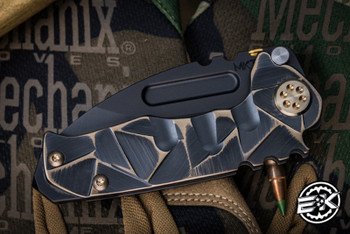Folding Knife Collection Care and Maintenance
Posted by Clayton on Feb 26th 2015
Even though understanding the internals of a pocketknife is not extremely difficult, it is crucial to have a general sense of the mechanics of the folding knife to give it the longest life possible. Common issues such as lint buildup, and problems with opening and closing the pivot prevent you from using your folding knives to their true potential.
Not only that, knife malfunctions can lead to serious injury. You do not want your knife to experience permanent damage due to preventable issues such as exposure to salt water or abrasive materials.
Make sure to conduct regular maintenance on your pocketknife. It is generally recommended that you lubricate your knife once a month or so. In the process of lubricating your knife, it is always a good idea to inspect it for other problems such as loose screws or rust/corrosion on the blade. Follow these basic steps, and you can watch your knife collection increase in value over the years.
Step 1: Keep Your Knife Clean
The most important parts of the knife that need constant cleaning include the pivot and the locking surfaces. When pocket lint accumulates, you should try using a screwdriver, toothpick, or other small pointy item to remove it. If you get grit or sand piling up in the corners, try using warm, soapy water to wash the knife with a toothbrush.
Once you have started cleaning your knife, you should do as complete a job as possible to avoid exposing your knife to water on a regular basis. More often than not, all it takes to restore your handle to its original quality is a consistent rinse with soapy water.
If the dirt and filth trapped in your knife do not come out this way, you are going to want to put the knife in a bowl of warm water to loosen the grime. However, you should be careful with this method because certain materials, such as wood, abalone, and mother-of-pearl, can be damaged if left soaking at high temperatures.
At this point, if your knife remains difficult to open, you might have to disassemble the knife to perform a more thorough cleaning. Taking apart your knife requires specialized tools and may void your warranty.
After you are done with the wet method of cleaning your knife, you are going to have to clean up any excess moisture and allow the knife to air-dry for at least fifteen minutes until you can lubricate. While your knife may be made of stainless steel, it can still become corroded.
Step 2: Choose a Lubricant
Since your pocketknife is a system that includes moving parts, you must always make sure to lubricate the mating surfaces, such as the pivot, slides, and any locking surfaces. The most frequently used lubricants are mainly petroleum-based wet lubricants. Alternatively, dry lubricants are Teflon based and usually attract much less pocket lint. Most of them usually come as a spray-on application or as a grease tube. It is extremely crucial to remember that if you plan on using your pocketknife for food preparation, you need to get a food-safe lubricant. Some people use vegetable oil, but it is not that stable and can smell bad. You should use a food-safe mineral oil, such as wood block oil.
Step 3: Apply the Lubricant
Most people think they need more lubricant than is necessary. Remember that a little bit goes a long way, and you should not overdo it. Open your knife and put only one or two drops of oil into the pivot and begin rotating the blade. Open and close it repeatedly in order to get the lubricant in all of the crevices.
Your goal should be to use just enough lubricant to get it into the target areas without soaking the handle of the blade. If you have too much lubricant on your knife, excessive lint will build up, and you will have to clean your knife frequently.
If your knife blade is comprised of high carbon steel, you might need to put a protective layer of lubricant on the blade itself. If you are using a knife with a wooden handle scale, you may want to rub it down with a finishing oil or wood polish. When you are done, wipe off any extra oil.
Final Thoughts
Always make sure your folding knife is in pristine condition. If you are having difficulty opening and closing it, you are going to have to remove the debris and properly lubricate it. Take special care of your folding knife if you are using it for culinary purposes. You are going to be thankful you took the time to clean it as you enjoy its frequent use and long life.

